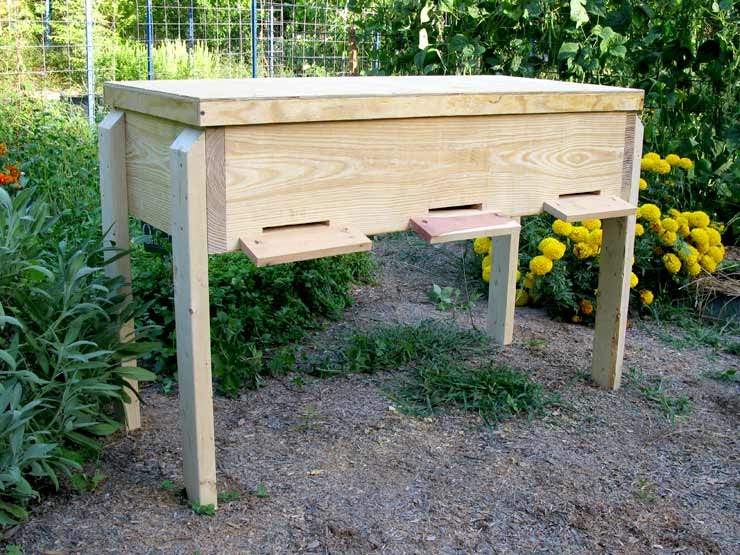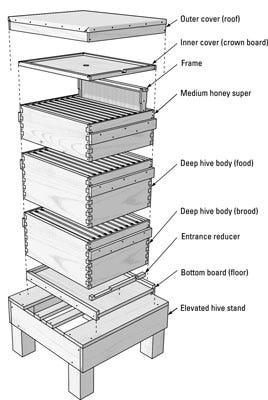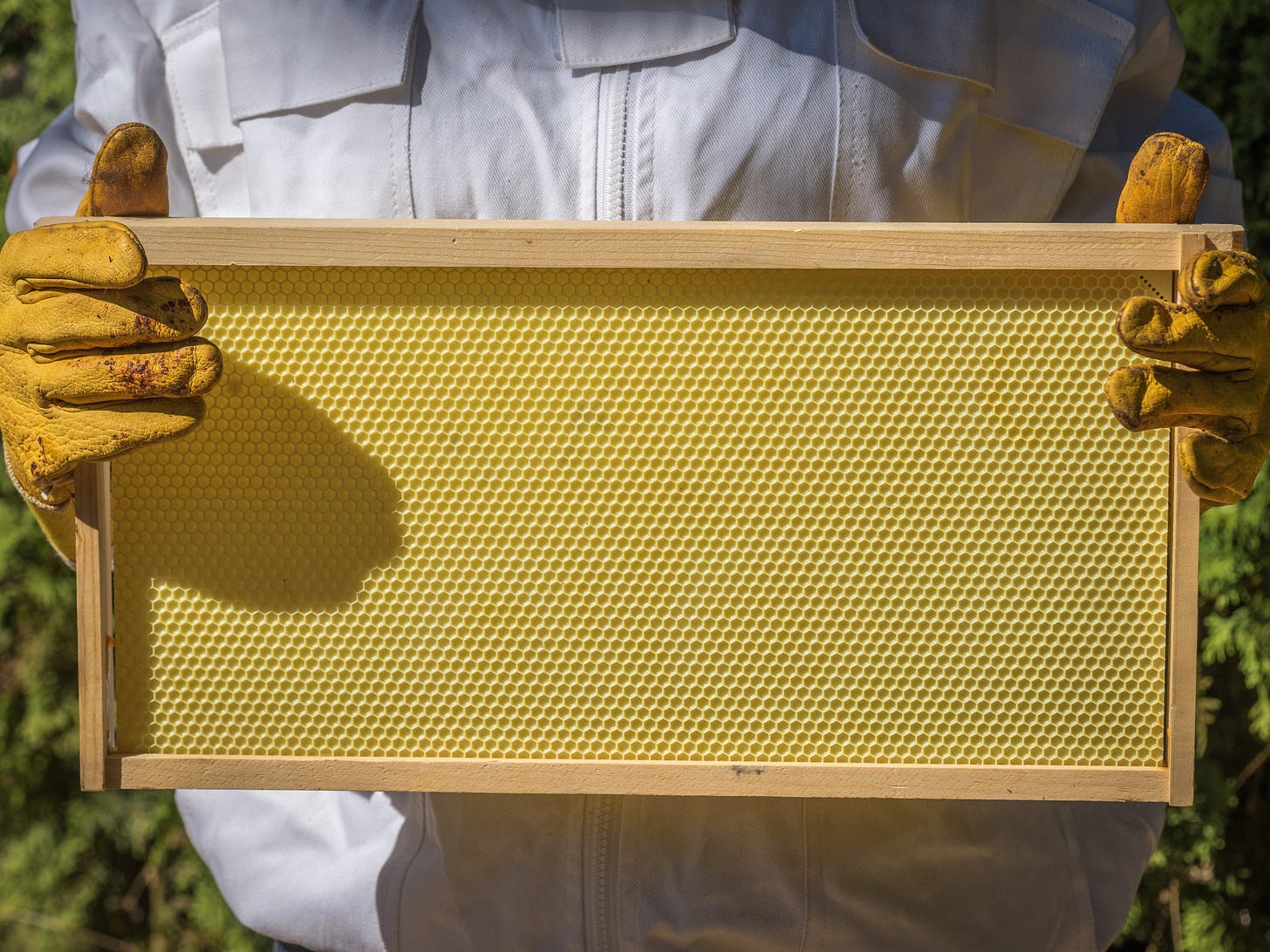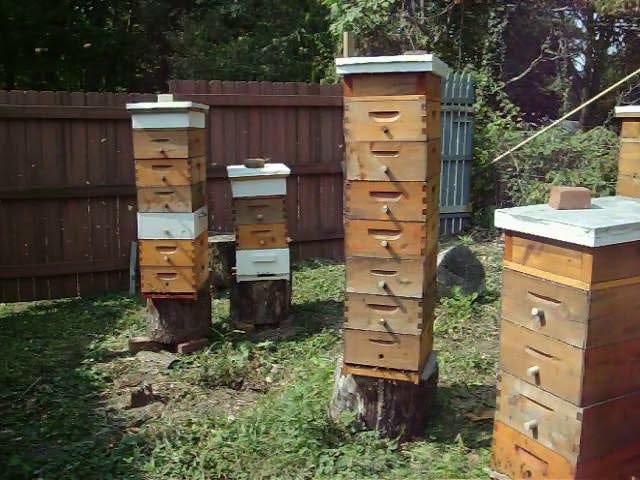A Deep Dive into Langstroth Hives: Innovation, Limitations, and Alternatives
The hive that accidentally became the global standard
The langstroth hive sits on homesteads and small farms across North America, and is by many considered the only hive worth using. But is it? The hive was developed by Reverend Lorenzo Langstroth, a clergyman, beekeeper, and teacher, who is considered today to be the father of American beekeeping. I wanna preface this with the fact that, while he’s the father of the modern beehives, we don’t actually use his design, and despite this credential, he didn’t *really* invent anything totally unique.
So, with that in mind, let’s go back in time, long long ago, to the 18th century. Swiss naturalist François Huber developed a “movable comb” or “movable frame” hive that featured wooded leaves filled with honeycombs that could be flipped like the pages of a book.1 Despite this innovation, Huber’s hive was not widely adopted and simple box hives remained the popular choice for beekeepers until the 1850s.
Enter Langstroth. While messing with side-open leaf hives that were popular in Europe, which were basically what they sound like, similar to Huber’s design, Langstroth came to a decision to build hives with removable frames. The idea was basically that less damage to the comb would be better for the hives. I know, you’re thinking that there’s no way no one thought of this for the previous hundreds, if not thousands of years. Well, the problem is that bees hate voids and tend to fill any open spaces with propolis, which is basically bee glue, to keep things in place and to reduce drafts. What made his design so valuable was that he figured out the spacing that was just big enough to stop the propolis application while wasting as little space as possible. And we’re talking about a centimeter.2
It’s important to contextualize the need to improve honey production; honey was much more important at this time than it is today because it was one of the only local sources of honey in northern climates. Beekeeping was, for Langstroth, a distraction from bouts of severe depression, so I’m guessing the Bible wasn’t solving all of his problems.3 Now this is the commonly told story about Langstroth developing his hives. However, Dr. Jan Dzierżon, a Polish apiarist, had in 1835 determined the correct spacing in beehives, 20 years prior.4 And Dzierżon’s discoveries were made based on the research of Petro Prokopovych, who had been working on refining bee space for decades.5
The thing is, Dr. Dzierżon published it, and Langstroth openly admitted that he knew of his work. But for some reason, all of that has been mostly ignored in reporting on the Langstroth hive, even though even today a quick Google search shows that fact. Reducing propolis might not seem like a big deal to a non-beekeeper, because I don’t think people really appreciate it when I say propolis is like glue. When they use propolis to glue stuff together you need a pry bar. So needless to say, it was a big deal to figure out how to make the hive as light as possible while producing honey and reducing this major issue. It’s so strong, propolis is actually strong enough to hold you together through depression.
Now, Langstroth wasn’t particularly impressed by modern hives, despite the fact that he was an amateur beekeeper. In his own words:
The result of all these investigations fell far short of my expectations. I became, however, most thoroughly convinced that no hives were fit to be used, unless they furnished uncommon protection against extremes of heat and more especially of cold. I accordingly discarded all thin hives made of inch stuff, and constructed my hives of doubled materials, enclosing a ‘dead air’ space all around.6
For the beekeeper folks listening, this might sound weird, because that’s not what the Langstroth hive looks like today, but there are a lot of people interested in insulating the Langstroth in recent years. I would love to see hives back at an inch thick— what he considered thin. Pine has traditionally been used, because it’s cheap and available even back then, but today’s hives are probably only 3/4” thick at best.
His design was a success— so much so it was quickly mimicked and he spent most of the rest of his career fighting legal battles over his patent, and it was modified and mass-produced by the industrial beekeeper A. I. Root.7 Root was an exception; Langstroth and Root remained friends and exchanged letters and best practices (you can see some of these letters in the source cited above).
So, let’s talk about what exactly makes up a Langstroth Hive. There are a few basic components I want to cover. There’s more to the hive than just what’s here, but having taken beekeeping classes myself, if this is your first time learning, all of the other stuff makes it harder to see the basic components, and we’ll start from the top to the bottom because, you know, people know what a roof looks like, but not a bottom board.
So the top: you have two covers— an inner cover and an outer cover. The outer cover protects the hive from rain, and the inner cover prevents the bees from gluing down the outer cover to the rest of the hive with propolis and wax. It also provides an air space just under the outer cover for insulation. Below this is where you’d keep your feeder, if you’re feeding the bees in the spring or fall, or your supers, which is where the surplus honey is stored by the colony. If they’re producing surplus honey, you don’t need a feeder, so you won’t have both of these on at the same time.
Below the supers is your hive body, which can be made from what’s called mediums or deeps, which are the same exact square boxes with the same frames as your supers. Mediums are 6 and 5/8 tall while deeps are 9 and 5/8 tall. Most folks today use mediums because they are much easier to maneuver— a honey-laden medium weighs around 40-45 pounds while a deep can weigh 70 pounds. The only thing that separates the supers from the mediums/deeps is that the mediums and deeps are used for rearing brood— baby bees— while the supers are for honey only. And you might think, well, how do they know? They don’t, so we put what’s called a queen excluder between the hive body and the supers, which has holes big enough for worker bees but too small for the queen to get into the supers and lay eggs. Lastly, below that is your bottom board, which is your beehive entrance.
Now, honeybees build comb in fairly predictable ways, and beekeepers take advantage of this tendency. In the wild, bees build combs in tree cavities, or sometimes under a building overhang or on a cliff face. Each comb is two-sided, meaning it has cells for brood or honey on both the front and back of a flat center panel. Beekeepers can provide a center panel for bees by using a wax foundation. Foundations are imprinted with hexagonal-patterned cell "floors," known as comb guides.
They’ll build around whatever, basically. But if you don’t use foundations, they won’t always go straight. On its surface, the system for keeping bees in a Langstroth hive appears exceedingly simple and streamlined, which attracts the attention of many beekeepers, especially newbies. While not the only type of hive I use, I still use them for the fact that I started using them so I’ve already got a bunch of materials, and they’re nice because they’re cheap to buy materials for.
In the spring, you’ve got your medium or deep out there with your new package of bees, and when they’ve got that mostly filled up, you add a second box. The queen will work her way up because it’s warmer and has more space. As that starts to fill up, you get a third medium, and you basically play hot potato and rotate the boxes so the new one is in the middle and the second box is on the bottom.
This is the thing that sucks about the Langstroths, despite all the other easy parts. There are actually a few shortfalls, but this one is the most confusing. Constantly rotating the frames full of bees and honey so that they travel around the hive the way you want, which isn’t the way they want, suggests that maybe it’s not the ideal situation. Now, why do we do this?
In nature, bees draw comb exclusively from the top down, and a tree hollow could never expand upward. Therefore, they sometimes ignore a new box set on top of the nest, and go about their business as if it wasn’t even there. Sometimes. But if you separate the two halves of the hive and insert a box in between them, then the bees will feel compelled to fill in the “hole”— they simply can’t help themselves. Why then, you ask, do the bees take to the very first box added in the spring?
The thought goes something like this: after winter and early spring spent in tight quarters, the bees are happy to find such vitally important space, without which they’d be unable to grow at all. On top of that, the total depth of a two-box deep nest is around 18 1/2 inches which is ideal for preparing for the coming winter in cool-temperate climates. We’ll talk about this in more detail in a following article. If you’re working with mediums, the same thing plays out for 3 boxes. Since bees won’t manage to prepare a nest for winter if it’s constantly being rearranged, a beekeeper should save a medium of honey and set it atop the nest portion of the hive come fall. Some amateur beekeepers do exactly that, but it’s a big hassle and cuts into your bottom line— and so, as a rule, the bees are often given sugar since it’s cheaper to prepare for winter.
I’ll add to this, because of the amount of work involved, this is one of those steps many beekeepers ignore, and for good reason— it’s something I’ve done and also ignored, and my own anecdotal evidence suggests this is unnecessary, although I’ve yet to see any research to back or challenge this process.
This brings us to the question of the long-term impacts of rotating the frames and disorienting the bees, especially moving into the winter. And further, what are the implications of how we harvest honey? To understand this, we need to understand how the hives operate during the winter in order to survive. Not only does the cluster eat in order to generate heat in the hive, but they slowly move up the hive throughout the winter— about a millimeter a day. A winter cluster of bees in cooler climates takes up eight to ten inches, leaving maybe an inch in the bottom box and then relying on the medium or deep above.

The point is that there’s very little honey in the brood box— most of it should be higher up, and it would normally if we didn’t harvest honey, but the super’s are almost always removed in conventional beekeeping today. That means that the honey left in the nest box will suffice for three months of wintering at most.
In the fall, you can shuffle the nest around and add frames full of honey or, you can remove the supers, force-feed the bees with sugar syrup, and let them decide themselves where to put it. But again, the hive tries to move up throughout the winter to retain heat and to eat the honey, and they’ll want to put it above the hive because that’s what they do in nature. Worker bees in the center, drones around the edges, with some reserve honey, and a majority of the honey will go above.
The root of the problem is obvious. A bee colony isn’t some honey-making machine, but a living, intelligent creature, and we should try to be more in tune with that. What can we do? We can not only make extra-deep frames, but people do and very often should. The challenge really is that the frames are heavy, and beekeeping can be a bit cultish around treatment methods and the box rotation. Part of it is because of how bees breed and how they can share diseases and so on, so it’s expected by many beekeepers that everyone should manage their bees the same way. And that’s a problem because it’s clearly not working, and we’ve been hinting at that throughout this series. So, needless to say, the people who are managing bees unconventionally tend to try to fly under the radar.
While we’ve talked about how bees move up the hive during the winter, they can still move horizontally while also moving up the hive. The concept of horizontal hives with extra-deep frames is more popular in places like Eastern Europe, but there’s no reason they couldn’t be used here in the United States.

It’s basically a topbar hive body concept applied to the Langstroth dimensions. So the thing is, while it might be the same hive, you still need to build a new box, and you can’t go out and buy it. You can, however, use the frames. It fixes a lot of the issues by making them deeper to increase room for honey production above, while still using a lot of the same, easy-to-source materials, especially for people who started with Langstroth and are tired of the challenges.
Research at this point doesn’t show any definitive differences in things like productivity or the microbial makeup of the hive based on different formats of Langstroths.8 A lot of the gimmicky type hives like the plastic ones, unsurprisingly, retain moisture more and this can cause some serious problems, so I wouldn’t recommend them, and the anecdotal expectations from seasoned beekeepers to be dismissive of these hives are backed up so far by the science.9
We have been talking a lot about going for bigger boxes in order to reduce the need for the musical chairs game and to make sure that the bees have enough stored honey, but there’s another, smaller version of Langstroth hives called Farrar hives, which basically tries to take the idea that the bees would like a little more space by constantly giving them just a little more space, and that’s had some pretty good results, in some cases increasing honey production by 15%.10
I mentioned earlier I had a few other reservations with traditional Langstroth hives, and I want to touch on those. The first major one is insulation. Langstroth understood this, but it seems to have been lost to time, and today many people are trying to reconstruct the hives to insulate the sides to help reduce how much energy bees use to stay warm during the winter.11 Part of this isn’t that it was forgotten, but that conventionally cut wood is actually thinner than it was back then. Some research has actually shown hives that are more insulated might still consume as much honey, but it’s because there’s less mortality, making the hive stronger for the spring.12
Up above, we highlighted the fact that honeybees create a ball inside the hive during the winter. The outer crust consists of older worker bees & drones that are more able to handle the cold, and if they die, not a huge loss, right? They eat and eventually, layers die off like the layers of an onion. But as the hive starts running out of food, they sacrifice more bees for the survival of the hive. So the insulation is more than just about the honey storage but keeps the colony stronger over the long term. The application of insulation to the roof of the hive has had similar effects, as well as reduced consumption during the winter, but basically, everything has pointed to more insulation being better for hives, with around a 25% increase in survival.13
My point here is that while the Langstroth has many benefits, there are still quite a few shortfalls that we can address, and we haven’t even gotten into why the Langstoth took over the bee industry— and the answer is simple. Langstroth hives are smaller and easier to stack and move around the country. That’s it.
Now, I don’t want to completely dismiss the Langstroth, because there are a lot of perks. What we can do is retool the resources and infrastructure that exist around the Langstroth to build better hives. Hopefully, if you’re new to beekeeping, this gives you a fair-ish critique of the hive your local beekeeping class will tell you to get.
If you’ve enjoyed this piece, which is equal to an 13-page chapter, of (so far) a 807-page book with 461 sources, you can support our work in a number of ways. The first is by sharing this article with folks you think would find it interesting. Second, you can listen to the audio version of this episode, #145, of the Poor Proles Almanac wherever you get your podcasts. Suppose you’d like to financially support the project, and get exclusive access to our limited paywalled content. In that case, you can become a paid subscriber on Substack or Patreon, which will both give you access to the paywalled content and in the case of Patreon, early access to the audio episodes as well.
Huber, F. (1808). New observations on the natural history of bees. John Anderson Jr.
https://explorepahistory.com/hmarker.php?markerId=1-A-3FE
Crane, Eva (1999). The world history of beekeeping and honey hunting. Taylor & Francis. pp. 421–422. ISBN 0415924677.
Graham, Joe. "American Bee Journal". American Bee Journal. 105.
Lorraine), L. L. L. (Lorenzo. (2019). Langstroth on the Hive and the honey-bee: A bee keeper’s Manual. Good Press.
https://search.amphilsoc.org/collections/view?docId=ead/Mss.B.L265-ead.xml#SeriesIII.LegalPapers.CourtDocumentsandPapers
Subotic, S., Boddicker, A. M., Nguyen, V. M., Rivers, J., Briles, C. E., & Mosier, A. C. (2019). Honey bee microbiome associated with different hive and sample types over a honey production season. PLOS ONE, 14(11). https://doi.org/10.1371/journal.pone.0223834
Erickson, Mikayla M; Salwei, Maggie L. (2020). Comparison of Plastic Apimaye Hive with Wooden Langstroth Hive for Improved Winterizing Efficiency and Mite Control. Retrieved from the University of Minnesota Digital Conservancy, https://hdl.handle.net/11299/217262.
Bajraktari, Z., Sena, L., & Sena, S. (2020). Comparative evaluation of the honey bee colonies’ performance based on two different sizes of hive boxes. Livestock Research for Rural Development, 32(8).
Thermal Impacts of apiculture on the bee colony. In New South Wales Apiarist Association Annual Conference, 2021-05-20 - 2021-05-21, Tamworth, Australia. (Unpublished)
Parrott, Jonathan “Effects of hive wrapping strategies on honey bee survival in western Massachusetts” SARE Grant project: https://projects.sare.org/project-reports/fne05-560/
St. Clair, A. L., Beach, N. J., & Dolezal, A. G. (2022). Honey bee hive covers reduce food consumption and colony mortality during overwintering. PLOS ONE, 17(4). https://doi.org/10.1371/journal.pone.0266219









